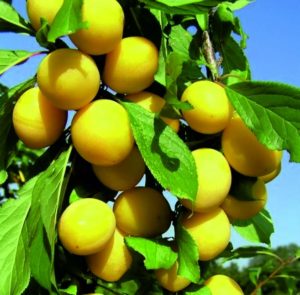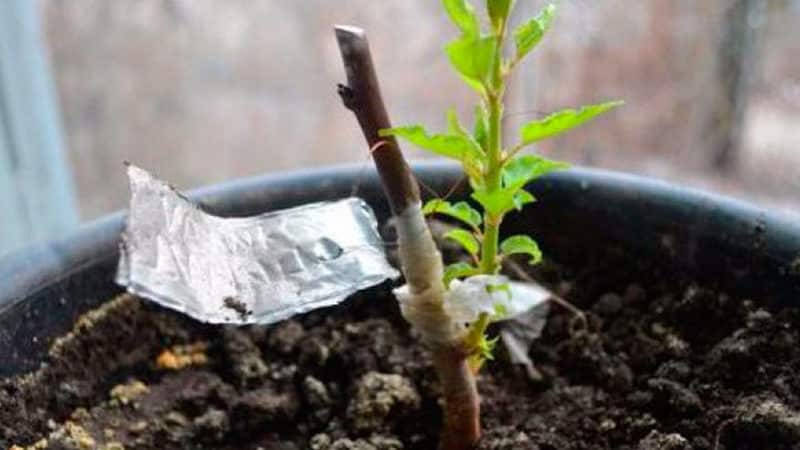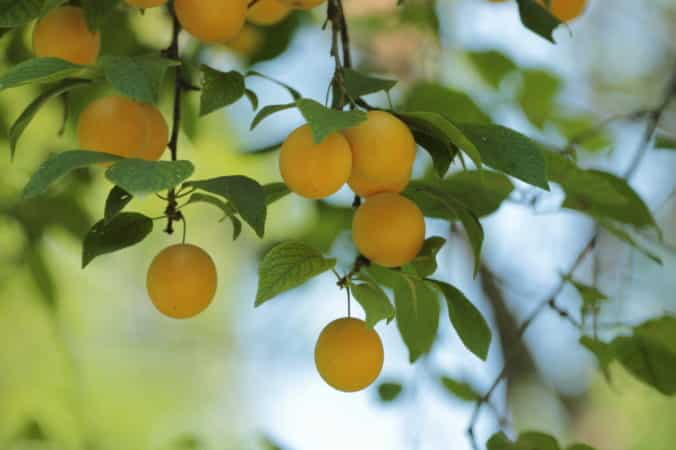Rules for propagating cherry plum cuttings in summer and stages of growing a tree from a twig
Cherry plum is an unpretentious shrub that easily takes root in a new place. It is grown by generative and vegetative methods. Most gardeners prefer to propagate cherry plums from cuttings. In this case, the plants quickly take root, develop correctly and retain their maternal characteristics.
The best time to take tree cuttings is spring and autumn. However, some gardeners carry out such work in the summer. Let's consider the subtleties of propagating cherry plum cuttings in the summer.
Is it possible to cut cherry plum in summer?
Cherry plum can be cut from spring, before flowering, or in autumn, after harvest. These periods are considered the most favorable, as they are accompanied by comfortable weather for rooting. At this time, the plant requires minimal care.
If you follow the rules for preparing and rooting planting material, as well as with subsequent proper care, the plant quickly takes root in the warm season. In this case, it will get stronger before frost and will easily survive the winter.

Advantages of summer cuttings of cherry plum:
- In summer, sap flow ends, so the plant is not injured when cutting branches. At the same time, the shoots already have time to wake up and begin to grow. They take root faster than those cut in the spring.
- Warm weather promotes intensive growth and root formation. There is no need to create special conditions for the seedlings; they will quickly take root in the open ground.
- The plants will have enough time to get stronger. They are less likely to die due to winter frosts than when planted in the fall.
- In summer, unlike spring, even a novice gardener will be able to see which shoots survived the winter and which froze.
Summer cuttings also have disadvantages:
- Hot, dry weather has a bad effect on the condition of seedlings. In order for them to take root, they will have to be protected from the scorching sun and watered frequently.
- In summer, the survival rate of cuttings is lower than in spring.
- Cuttings will have to be rooted immediately after cutting. In spring and autumn, this procedure can be postponed.
When planting in summer, it is important to carry out work when the sun is least active. This is done on cloudy days, in the morning or evening.
Optimal timing for summer cuttings
In order for the cuttings to quickly take root and have time to take root, it is important to choose the right timing for cuttings. Then, when cutting the planting material, the mother plant will not be harmed.
Cuttings of fruit trees are carried out after they have flowered. Green planting material is cut in June or July. It is recommended to take lignified cuttings and layering in August.
Cherry plum cuttings are possible from June to August. The main thing is that by the time the planting material is harvested, the plant has completed flowering.
Important! Vegetative parts cannot be harvested during the flowering period. Such cuttings will not take root, and the yield of the mother plant will decrease.
In summer, cuttings are carried out in the morning or evening, when the sun is not active. If possible, the procedure is transferred to cloudy but dry days.
Favorable days
Agronomists are still arguing whether it is important to take into account the lunar calendar when carrying out gardening work.Most gardeners are confident that the lunar day affects the growth and survival rate of plants.
In July 2020, cuttings and rooting are best carried out on the 14th and 15th (Taurus phase, waning Moon), 23rd and 24th (Virgo phase, waxing Moon).
Suitable cherry plum varieties
Cherry plum, unlike plum, is easily propagated by cuttings. Green planting material takes root regardless of varieties. Lignified cuttings are more difficult to root; this method is not suitable for all plants.
Hybrids take root the worst. The list contains plants that easily take root in Russian conditions:
- Gold autumn. A productive self-sterile variety. Each year it produces bright yellow fruits weighing 15–20 g, which ripen in the second half of August. The fruits hang and do not fall until the end of October. The flowers can withstand frosts down to -7°C.

- Kuban comet. A self-fertile plant that produces large red fruits weighing up to 29 g. Tasting score: 4.4–4.6 points. Frost resistance and yield indicators are high; 10–50 kg of fruits are harvested from 1 tree.
- Nectarine aromatic. Self-fertile plant with large dark burgundy fruits weighing up to 52 g. The pulp is juicy, with the taste and aroma of nectarine, the juice is thick. Winter hardiness is high.
- Traveler. Self-sterile cherry plum. The fruits are red on the outside, orange on the inside. Banana taste. The tree has high resistance to diseases and winter frosts.
- Apricot. Self-fertile variety. The pinkish-orange fruit weighs about 26 g and tastes like an apricot. Increased frost resistance (up to -35°C).
Selection and preparation of cuttings
Before growing cherry plum from a branch, it is important to choose the right planting material. You can root green cuttings, woody branches, root shoots and air layering.
Greens

One of the most common propagation methods involves the use of green, semi-lignified cuttings. Such shoots are not herbaceous, quite strong and elastic, but still very flexible, since they have not yet become lignified.
These are branches of the current year that have a reddish area at the base and a bright green tint along the entire length. They quickly take root and begin to grow. The chances that such planting material will take root are high.
For propagation, trees are chosen that bear fruit abundantly and tolerate drought and winter frosts well. It is important that the plant does not have damage, formations on the bark, spots on the leaves and other signs of damage by diseases and pests.
Harvesting green cuttings lasts from June 10 to the end of July. The procedure is carried out when the sun is not active.
Instructions for preparing green planting material:
- A day before cutting, the mother plant is watered abundantly (at least 3 buckets of water are used per tree). It is advisable to add a growth stimulator.
- In non-sunny weather, cut green branches 25–30 cm long and no smaller in diameter than a pencil. After being separated from the mother plant, they are placed in a container with clean water.
- The branches are cut so that each segment has 2-3 leaves at the top and a 3 cm long stem under the leaves. The upper cut is made even, 0.5 cm away from the bud, and the lower cut at an angle of 45°.
- The cuttings are soaked for half an hour in a light pink solution of potassium permanganate, then placed for a day in a root formation stimulator (“Heteroauxin” or “Kornevin”).
Green cuttings will take root within 2–4 weeks if favorable conditions are created. On average, about 60% of the collected planting material takes root.
Numb
Propagation by woody branches is not as effective as by green cuttings. Use annual shoots that have already become covered with bark of the appropriate shade. There should be no damage, cracks, stains or other formations on them.
It is best to harvest such cuttings after leaf fall, but this can also be done in the second half of August. It is recommended to harvest extra branches that would have to be cut anyway.
Cuttings 0.7–1.2 cm thick and 20–30 cm long are suitable. For rooting in a greenhouse, cuttings 5–10 cm long are suitable. The number of internodes should be at least 3.
Attention! Before cutting, it is important to make sure that the branch has not dried out. It should be flexible enough, and the surface under the bark of a living shoot should be moist.
When harvesting lignified cuttings, an oblique cut is made both from above and from below. The lower and central parts of the shoot are suitable for cuttings.
Air layering
Using air layering involves growing roots on a branch that is not separated from the tree. Work is carried out in May or early June.
How to propagate cherry plum by air layering:

- They choose last year's branch. It should be straight, without branches, growths, damage, stains, or signs of damage by diseases and pests.
- All shoots are removed from the branch so that there are no stumps left on it.
- In the central part, closer to the base, a ring of bark is removed. To do this, use a sharp knife to make an incision in a circle to the depth of the upper layer of bark, step 1 cm away from it and make a second similar incision.
- A solution of a root formation stimulator is applied to the resulting cut.
- The branch is threaded into a plastic bag, breaking through the bottom. It is pulled over the shoot so that the lower edge is 10 cm below the ring of cut bark.The bottom edge of the bag is tightly fixed with electrical tape.
- Nutrient soil is poured into the bag so that it covers the cut ring. The soil is moistened with water at room temperature or a solution of a growth stimulator.
- The bag is tied at both ends with electrical tape to make it look like a bag. Make several small holes.
After the roots appear, the upper part of the branch is cut in half. Remove the bag and separate the shoot from the mother plant immediately before planting.
There is another way to root a shoot - without separation from the mother plant. To do this, the shoot is bent to the ground, fixed with a bracket, and covered with soil. Water it as the soil dries out, periodically feed it, and weed it.
Root growth
Another method is propagation by root shoots. To do this, choose a shoot located at the maximum distance from the tree.
Attention! Only self-rooted plants are propagated by cuttings. If the mother tree was grafted onto a rootstock, the cherry plum grown from its branches may not retain its parental characteristics.
During the summer, the future seedling is fed, watered, hilled, and weeded. At the end of August, the cuttings are dug up, carefully separating the root system from the mother one.
Rooting methods

Green and woody cuttings require preliminary rooting. Typically gardeners use the following methods:
- For green cuttings in a greenhouse. The soil for planting is mixed with peat, humus, and superphosphate. The cuttings are buried 3 cm so that the bottom leaf is above the ground. The soil is watered abundantly. A distance of 5 cm is maintained between the cuttings. When rooting in open ground, a frame is made of film arcs, onto which the film is pulled.The temperature during germination should be maintained within +25…+30°C. After a month (by this time the first roots have formed), the plantings are fed with mineral fertilizers. The soil is moistened as it dries. After the roots have formed, ventilation begins, gradually increasing their duration. For the winter, the seedlings are covered with peat or dry leaves.
- For woody cuttings. They are soaked for a day in a growth stimulator. Shallow notches are made on the bark at the bottom of the branches. The cuttings are planted in moist nutrient soil so that the lower bud is underground. In the summer, the cuttings are watered and fed, and in the winter they are covered with fallen leaves or peat.
- At home. The cuttings are stuck into a container filled with moist nutrient soil. Cover the top with a cut bottle or bag. As the soil dries, moisten it. A month after planting, the cuttings are fed. After the formation of the first roots, the plants begin to ventilate, gradually increasing the duration of the procedure.
Landing
Summer cuttings are also planted in the fall, but it is better to do this next spring. In this case, the plant will not die in frost, but before the next winter it will have time to get stronger and get used to new conditions.
For cherry plums, choose a sunny place protected from the wind. It is important that groundwater is not located closer than 1.5 m to the surface. At least a month before planting the tree in a permanent place, the soil is prepared: it is cleared of weeds and plant debris, dug up, and watered with a hot solution of copper sulfate.
Dig a hole 50 cm deep and 70 cm wide. Drainage is poured onto the bottom (gravel, expanded clay, small crushed stone).The excavated soil is mixed with potassium chloride, humus, superphosphate, ammonium nitrate, and river sand.
Part of the fertile soil is poured back into the hole. An earthen mound is formed in the center. The seedling is placed on a mound, distributing the roots evenly around the hill. A stick is stuck nearby to serve as a support. For reliability, a plant is tied to it.
The hole is covered with earth and compacted. The plant is watered with 2-3 buckets of water. The root collar should be 5 cm above the ground. The tree trunk circle is mulched with hay, straw, peat or humus. This will protect the plant from diseases, pests, cold weather, and weeds.
Features of cuttings depending on the type of cherry plum and region
Cherry plum takes root and takes root in a new place much easier than plum. Difficulties usually arise only with hybrids.
Advice! If, after several attempts, seedlings of a certain variety do not take root, it is propagated by grafting. Usually a cultivated scion is grafted onto a wild one (grown from seed) rootstock. Such a plant will be the strongest and most resilient.
There are slow-rooting and fast-rooting varieties. While the former need about 2 weeks to form adventitious roots, the latter require at least a month.
Varieties are chosen taking into account the climate of the region. For areas with warm weather, all options are suitable, but preference is given to cherry plums with resistance to heat and drought. For the northern and central regions, early-ripening plants with high frost resistance are optimal.
Further care

In order for the cherry plum to take root, develop and bear fruit, it is important to properly care for it:
- In dry summers, young plants need watering at least 2 times a month. 2-3 buckets of water at room temperature are poured under 1 tree.
- To destroy the earthen crust and normalize air exchange, the soil is loosened the next day after each watering and precipitation. Weeds must be removed from the tree trunks of young plants.
- First 3 years after landings cherry plum does not need to be fed. Then fertilizers are applied 2–4 times a year, alternating mineral and organic compounds.
- In the first year, the cherry plum is not pruned, then the crown begins to form. Every year, in autumn or spring, sanitary pruning is carried out, removing damaged, weak, dry branches and root shoots.
- In order for the tree to easily survive the winter, the soil in the tree trunk circle is mulched. To protect the plant from diseases and pests, it is recommended to carry out this procedure in the summer. In autumn, the tree trunk circle is cleared of leaves and plant debris.
- To reduce the risk of cherry plum infection by diseases and pests, in the spring, before flowering, and in the fall, after fruiting, the tree is sprayed with a solution of copper sulfate.
Advice from experienced gardeners
There are several secrets that will make caring for cherry plum easier and increase the chances that it will take root after planting:
- It is not recommended to root cherry plum cuttings in water: in such conditions they do not take root well and often rot.
- Many gardeners argue that it is not necessary to make cuts on planting material at an angle.
- Before cuttings, the mother tree is watered abundantly, but not fed.
- If it is not possible to start rooting the cuttings immediately after cutting, they are wrapped in damp material and placed in a cool place. In this form they are stored for up to 2 weeks.
- Before use, the pruning shears must be wiped with alcohol or a dark pink solution of potassium permanganate for disinfection.
Conclusion
Cherry plum is an unpretentious plant that is easily propagated vegetatively.
Many gardeners use green cuttings as planting material. They quickly take root and take root in a new place. Lignified shoots, air layering and root shoots are also suitable.